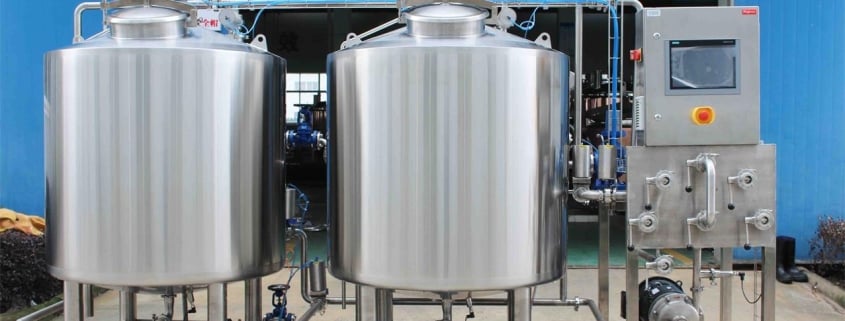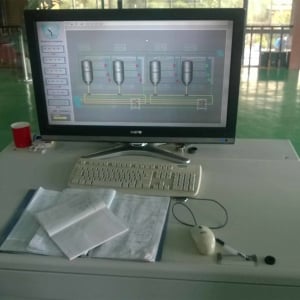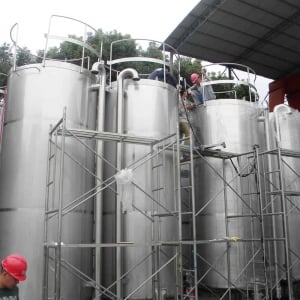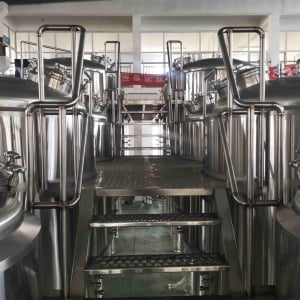9 Gallon Wort Grant
A 9 gallon wort grant is a key component of a brewing system that allows transferring of wort from the mash tun to the brew kettle. It acts as an intermediate holding vessel between the mash tun and kettle to help regulate wort flow.
Benefits of using a wort grant include:
- Allows continuous sparging from the mash tun without overflowing the kettle
- Helps maintain a consistent boil in the kettle by regulating wort flow
- Prevents a stuck sparge by providing a holding reservoir
- Keeps a solid hot break formation for better beer clarity
- Often fitted with a thermometer and sight glass for monitoring
- Can be insulated to maintain precise wort temperatures
Key features to evaluate in a wort grant:
Table 1. Main Features Comparison
| Feature | Details |
|---|---|
| Size | Typically 9 gallon capacity |
| Construction | Stainless steel preferred |
| Insulation | Insulated protects wort quality |
| Fittings | Valves and tubing connectors for transfers |
| Gauges | Thermometer and sight glass as standard |
| Design | Compact; cylindrical or rectangular designs |
Size: The most common size is 9 gallons as this provides sufficient capacity between a typical 10 gallon brew kettle and a standard mash tun used by homebrewers and craft breweries. The 9 gallon size can regulate flow rates up to 5 gallons per minute in most systems.
Construction: Stainless steel is the optimal material to prevent corrosion and ensure cleaning and longevity. Some models use aluminum or copper but require protective liners.
Insulation: Insulating the grant with a thick jacket helps maintain precise wort temperatures during transfers to ensure optimal enzyme conversion and prevent cold side oxidation. Uninsulated units can lose 5°F or more.
Fittings and Connections: Essential fittings include inlet and outlet valves, a pressure relief valve or blowoff arm, and camlock/triclover adapters to connect hoses/tubing to the mash tun and kettle.
Instrumentation: Most grants have a thermometer for temperature monitoring. A sight glass allows viewing liquid levels. Some add more advanced probes and automation.
Design: Typical designs are cylindrical vessels or rectangular boxes optimized for compactness since space is often limited. They may stack above the mash tun or sit alongside it. Custom etching like volume gallon markings and brewery branding can be added.
Now let’s get into more specifics on types of 9 gallon wort grants, sizing considerations, how to select the right model, installation factors, operation practices, maintenance, suppliers and pricing.
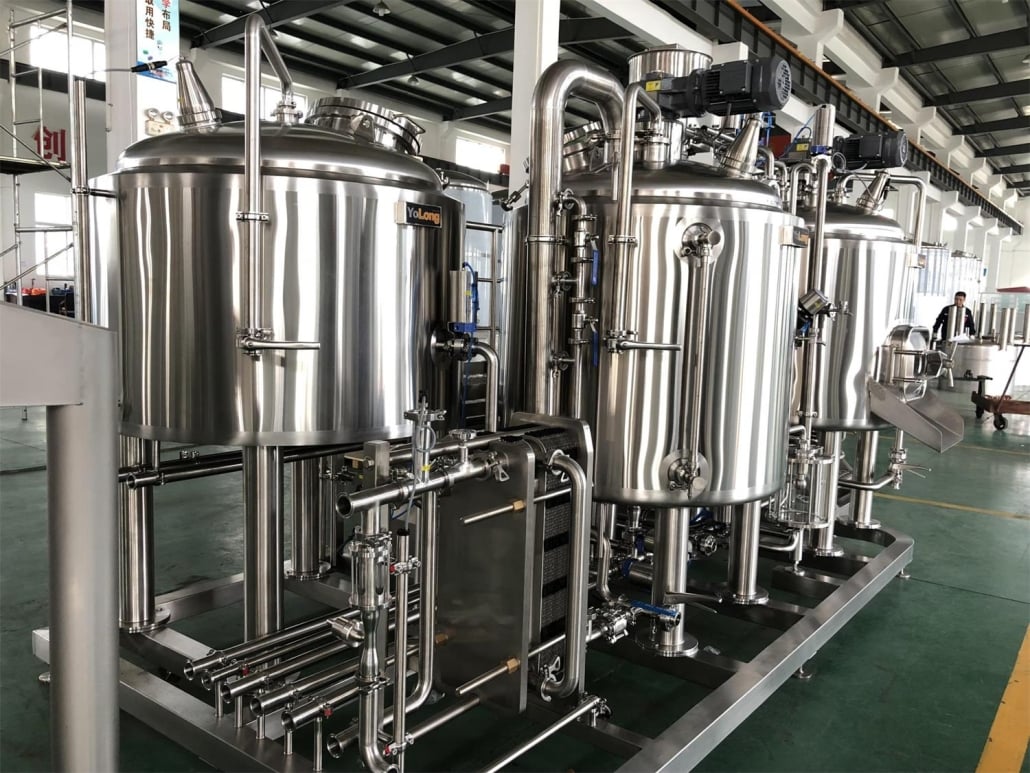
Types of 9 Gallon Wort Grants
Wort grants are available in different shapes and insulation levels as summarized below:
Table 2. Wort Grant Types Comparison
| Type | Details |
|---|---|
| Cylindrical | Column-style cylindrical vessel; common |
| Rectangular | Square or rectangular short wider shape |
| Insulated | 1-2″ insulation jacket |
| Uninsulated | Lower cost but less temp control |
| Customized | Branding, fittings, etc. |
Cylindrical 9 Gallon Wort Grant
The standard cylindrical style grant looks like a small stainless tank, optimized for efficient cleaning. They have a height that allows connecting to standard mash tuns and kettles in typical brew deck arrangements. Cylindrical vessels also reduce trub and hop debris build up with cone-shaped bottoms.
Rectangular Shaped Model
Some manufacturers like Spike Brewing offer more compact rectangular cooler-style grants. These maximize space efficiency but can be harder to clean than cylindrical tanks. Ensure there are adequate ports/fittings for cleaning access.
Insulated Grants
Insulated grants have thick insulation surrounding the inner vessel to regulate temperatures. They prevent heat loss and cold-side oxidation while allowing continuous volume transfer. Insulation does add cost over non-insulated models.
Uninsulated Units
Simple stainless vessels without insulation can save on budget but compromise on temperature control. Factor in some temperature loss during transfers or add heating elements if going uninsulated.
Customized Models
Many fabricators like JV Northwest allow custom etching of volume markings, logos, manufacturer branding and other embellishments to stainless grants upon request. Additional fittings or instrumentation can also be accommodated. That allows perfect match to your specific brewhouse layout and needs though at a small premium.
Sizing a 9 Gallon Wort Grant
Properly sizing the wort grant volume and flow capacity prevents kettle boiling over or stuck mashes.
Table 3. Sizing Factors
| Considerations | Details |
|---|---|
| Volume | Standard 9 gallon capacity |
| Peak flow rate | Up to 5 GPM |
| Height | Fits brew deck space |
| Fittings | Match mash tun and kettle |
| Headspace | Avoid boilover with 15% extra |
Volume Capacity
The most widely used size is a 9 gallon capacity. This safely supports 5 gallon homebrew batches without over flowing or limiting continuous sparging given typical tun sizes. Commercial systems scale accordingly.
Peak Flow Rates
The maximum flow rate for 9 gallon capacity is around 4-5 GPM to avoid overflow. Flow is regulated via outlet valves.
Sizing Height
Measure space between your mash tun bottom and kettle rim height. The grant must safely transfer wort between. Account for hoses and fittings at both ends when selecting the height.
Fittings and Connections
Determine the exact hose, camlock and triclover fitting sizes needed to integrate with the current mash tun discharge and kettle inlet. Specify these when ordering a grant.
Added Headspace
Even with flow rate regulation, boilovers can occur so allow 15% extra capacity by selecting a 10 gallon+ size grant. This prevents major spillovers. Having a blowoff arm as backup also helps.
Properly sizing the wort grant volume, dimensions and connections ensures it seamlessly integrates for syrup transfers in your current brew deck layout.
How to Select a 9 Gallon Wort Grant
Follow this decision checklist when selecting a wort grant model:
Table 4. Wort Grant Selection Factors
| Considerations | Details |
|---|---|
| Size | Standard 9 gallons |
| Construction | Stainless steel grade |
| Insulation | Insulated recommended |
| Fittings | Camlocks etc. |
| Instrumentation | Thermometer; sight glass |
| Design | Cylindrical or rectangular |
| Portability | Wheels or fixed |
| Lead time | 6-12 weeks normal |
| Budget | Up to $2000 USD |
| Warranty | 1-2 years usual |
| Certifications | Optional |
| Supplier reputation | Check reviews |
Walk through each selection criteria to choose the right wort grant:
Size: Specify 9 gallon capacity for optimal functionality. Go slightly larger at 10-15 gallon where peak flow rates demand.
Construction: Opt for stainless steel for longevity and cleaning – grades 304 or 316 common.
Insulation: Insulated jacket recommended unless adding heating elements. Prevents cold side oxidation.
Fittings: Specify all connection sizes, types, positions based on mash tun and kettle.
Instrumentation: Thermometer essential; sight glass allows easy volume viewing.
Design: Cylindrical or cube shape based on space constraints.
Mobility: Stationary or add casters for portability where needed.
Lead Times: Quality grants have 6-12 week typical delivery times.
Budget: Up to $2000 for a professional stainless, insulated 9 gallon unit.
Warranty: Ideally 1-2 year parts and defects warranty from reputable manufacturers.
Certifications: Optional 3A dairy compliance, ASME pressure vessel codes may suit commercial breweries better.
Supplier: Vet supplier reputation and ability to deliver quality grants with good customer service.
Carefully evaluating each selection criteria results in the best grant for production needs and budget.
Installing a 9 Gallon Wort Grant
Proper installation of the grant enables efficient wort transfer flows in the brewdeck layout between the mash tun and kettle:
Table 5. Installation Considerations
| Factor | Details |
|---|---|
| Location | Adjacent to the mash tun |
| Height | Align within 6” of kettle rim |
| Connections | Fit hoses or tubing for wort transfers |
| Stand | Optional structural stand below |
| Insulate | Wrap any exterior piping |
| Test | Test transfer flows are unobstructed |
Position adjacent to the mash tun for shortest runs. This allows optimal wort flow control.
Align height equal to the kettle rim or within 6” for easy gravity transfers.
Connect hoses or tubing between the mash tun outlet and kettle inlet via the grant valves. Insulate any exterior tubing runs.
Optional stand can raise the grant if space constrained. Customize to fit.
Insulation helps maintain precise wort temperatures and prevent oxidation.
Test transfers with water first to ensure unobstructed flow through the full system.
Take care to optimize grant position and connections during installation for efficiency.
Operating a 9 Gallon Wort Grant
Follow best practice grant operation:
Table 6. Operation Guidelines
| Procedure | Details |
|---|---|
| Fill levels | Fill only up to maximum volume |
| Flow rates | Control runoff via outlet valve |
| Temperatures | Maintain within 1-2°F |
| Adjust flows | Prevent mash tun dryness |
| Clean thoroughly | After each batch with caustics |
Fill levels – Avoid overfilling the grant. Adhere to manufacturer rated maximum capacity. Overflows can cause burns.
Flow rates – Use inlet/outlet valves to regulate flows and prevent flooding. Start slower until kettle at capacity.
Temperatures – Keep the wort within 1-2°F between the mash, grant and kettle for consistency.
Adjust flows – If mash tun runs dry, slow the outlet valve to allow liquid reservoir.
Clean thoroughly after each batch using caustic chemicals through all openings.
Follow the wort grant operational guidelines above to sustain efficient functional transfers batch after batch.
Maintaining a 9 Gallon Wort Grant
Proper cleaning and maintenance maximizes grant life expectancy over thousands of batches:
Table 7. Maintenance Factors
| Activity | Frequency |
|---|---|
| Cleaning | Each batch with caustics |
| Inspection | Monthly visual inspection |
| Replacing | Gaskets every year |
| Testing | Verify temp gauge yearly |
| Repairs | As needed |
| Upgrade | Every 2-5 years |
Cleaning – Flush hot caustic solution through all fittings after every brew day. Rinse well before next use.
Inspection – Visually inspect fittings, gaskets, seals monthly for wear and issues.
Gasket replacement – Change liquid seals annually prevent leaks or blowouts.
Testing – Calibrate thermometer yearly for accuracy.
Repairs – Service issues like leaks or dead instrumentation as needed.
Upgrade – Improved control systems after 2-5 years extend capabilities.
Following the maintenance activities above ensures the 9 gallon wort grant remains in service for the long haul.
Suppliers of 9 Gallon Wort Grants
Many brewhouse fabrication companies offer quality stainless wort grants with customization options at reasonable pricing:
Table 8. Grant Suppliers
| Supplier | Prices | Lead Time | Rating |
|---|---|---|---|
| JV Northwest | $1000-$2500 | 6-12 weeks | A |
| Spike Brewing | $1200-$2000 | 6-8 weeks | A |
| BrewHardware | $1000-$1800 | 4-8 weeks | B+ |
| Colorado Brew Tech | $900-$2000 | 4-10 weeks | B |
| Keg King | $800-$1500 | 8-16 weeks | B- |
JV Northwest – Offers insulated stainless custom etched grants made in USA to order from $1000-$2500 with quick 6-12 week delivery and great 5 star reputation.
Spike Brewing – Known for their kettles and rectangular cooler grants from $1200-$2000 with reasonable 6-8 week ships. Top rated customer service.
BrewHardware – Wide range under $2000 including economy options as low as $1000 shipping in 4-8 weeks usually. Decent brand.
Colorado BrewTech – Mid-range semi-custom grants cost $900-$2000 with longer 4-10 week ship times but solid quality.
Keg King – Budget level import grants from Australia under $1500. Longer lead up to 16 weeks but cost effective.
Evaluate each grant supplier across pricing, manufacture time, reputation, features and warranty to select the best product match.
Comparing 9 Gallon Wort Grants
There are some key tradeoffs when selecting a 9 gallon wort grant for your brewhouse:
Table 9. Grant Comparison Factors
| Consideration | Benefits | Downsides |
|---|---|---|
| Insulated | Better temp control | Added cost |
| Rectangular | Compactness | Harder to clean |
| Uninsulated | Lower budget | Temp fluctuations |
| Customized | Perfect fit | Slightly longer lead |
| Imported | Cost savings | Quality variability |
| Economy | Affordability | Potential longevity issues |
Insulated grants enable solid mash temp stability and prevent cold side oxidation but add 30-50% cost over uninsulated.
Rectangular cooler shape can maximize head clearance in shorter spaces but cylindrical is easier to clean.
Uninsulated stainless helps budget but temperature control suffers during transfers.
Customization allows tailored measurement, logos, fittings according to brew deck layout for a perfect fit at the expense of possibly 1-2 week longer lead time.
Imported economy grants from China or Australia can save money over American-made but sometimes run into more quality issues.
Entry level budget grants under $1000 compromise on some material gauge, seals and insulation to meet costs but may not have the longevity of premium level.
Weigh your primary deciding factors like budget, temperature stability needs, customization requirements and expected lifetime accurately before picking a 9 gallon wort grant system.
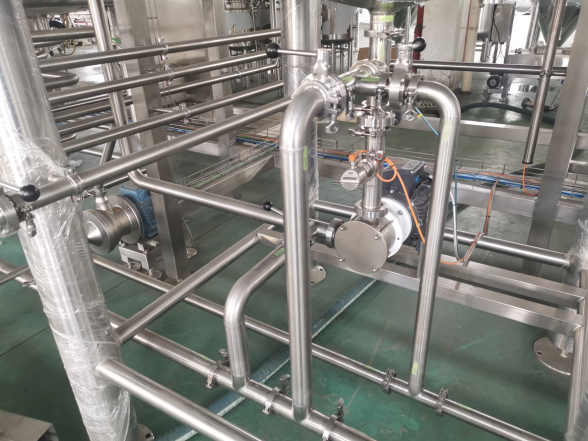
FAQ
Q: What size batches can a 9 gallon grant support?
A: A 9 gallon wort grant is ideally suited for 5-10 gallon homebrew batches. It has sufficient capacity to prevent kettle boil overs or mash tun runoff restrictions at those batch scales with standard tun sizes while allowing flexibility for larger 15-20bbl commercial scaleups.
Q: Should I insulate the grant or not?
A: An insulated grant is strongly recommended for most brewers to help maintain precise mash temperatures and prevent cold side oxidation issues during transfers. Uninsulated grants can lose 5°F quickly. Only go uninsulated if adding heating elements or maximizing short term cost savings and accept some temperature fluctuations.
Q: How narrow can the grant be?
A: For cleaning access, allow at least 12-18 inch diameter for cylindrical vessels. Rectangular grants should have at least 8 inches clearance across their narrowest width again to allow cleaning brushes, hoses and caustic solution contact completely internally.
Q: Can grants be stacked?
A: Yes, grants can sometimes be stacked above the mash tuns by using extension legs or supports though overhead clearance needs to be evaluated in this case. Stacking may complicate hoses and future mobility but can work where floor space extremely limited.
Q: Should I automate the grant?
A: Basic grants will run under manual control of inlet/outlet valves to regulate flow rates. Upgrading to automated PID digital controls allows very finely tuned temp stability and transfers optimized across the brewhouse if desired but adds cost for commercial facilities looking to maximize consistency and repeatability.

